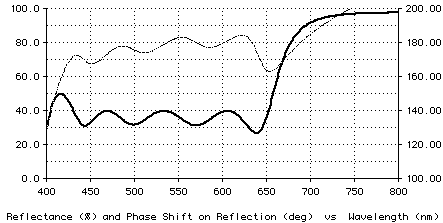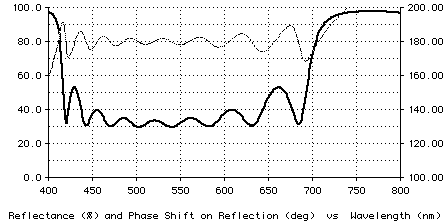Coating for a Fabry-Perot Interferometer
A. Reflectance between 30% and 40% for wavelengths 430-630 nm
B. Reflectance greater than 97% at 780 nm
C. Nearly constant phase shift on reflection for wavelengths 430-630 nm
This coating is on glass (index 1.52) and light is at normal incidence. This problem is ideal for the needle/tunneling method because it is not obvious how complex the final design will have to be. Also note that this design problem uses (1) inequality targets for the first requirement and (2) derivative targets for the third requirement (which is the same as requiring the first derivative to be zero for wavelengths 430-630 nm).
Starting with a single thin layer, the needle/tunneling method found a sequence of 5 optimal designs, the last of which is shown below. The thick line is reflectance; the thin line is phase shift on reflection. Two coating materials were used: H (2.35) and L (1.38).


TFCalc Paper
L 178.83 200.00
H 98.46 108.33
L 144.97 400.00
H 89.65 108.33
L 138.21 400.00
H 89.51 108.33
L 140.74 400.00
H 96.01 108.33
L 131.29 400.00
H 51.51 54.17
A design was submitted by Dr. H. Zorc (zorc@olimp.irb.hr), who used TFCalc's global optimization capability to find the best 10-layer design. After local optimization, that design was reduced to 9 layers:
Zorc
H 99.78
L 146.32
H 89.94
L 130.38
H 91.04
L 126.61
H 97.11
L 116.07
H 60.55
This design, which has fewer layers and which is thinner, also has a slightly better phase
shift curve. Thank you, Dr. Zorc!